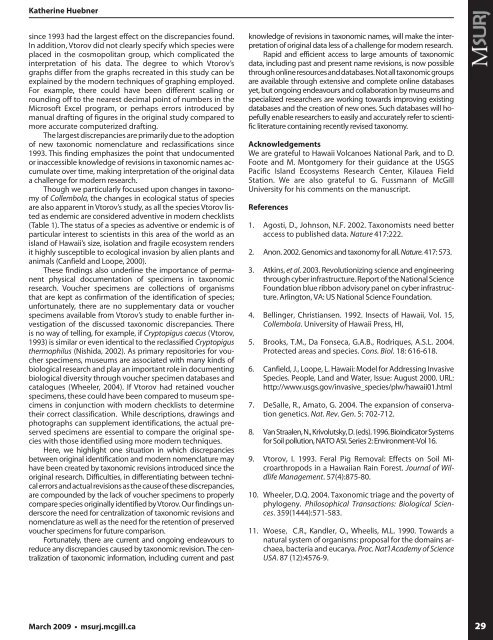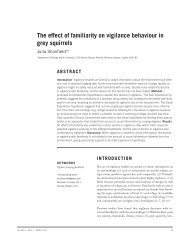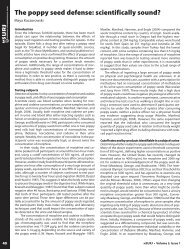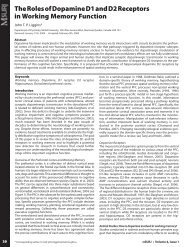the entire issue - McGill Science Undergraduate Research Journal ...
the entire issue - McGill Science Undergraduate Research Journal ...
the entire issue - McGill Science Undergraduate Research Journal ...
Create successful ePaper yourself
Turn your PDF publications into a flip-book with our unique Google optimized e-Paper software.
Ka<strong>the</strong>rine Huebner<br />
since 1993 had <strong>the</strong> largest effect on <strong>the</strong> discrepancies found.<br />
In addition, Vtorov did not clearly specify which species were<br />
placed in <strong>the</strong> cosmopolitan group, which complicated <strong>the</strong><br />
interpretation of his data. The degree to which Vtorov’s<br />
graphs differ from <strong>the</strong> graphs recreated in this study can be<br />
explained by <strong>the</strong> modern techniques of graphing employed.<br />
For example, <strong>the</strong>re could have been different scaling or<br />
rounding off to <strong>the</strong> nearest decimal point of numbers in <strong>the</strong><br />
Microsoft Excel program, or perhaps errors introduced by<br />
manual drafting of figures in <strong>the</strong> original study compared to<br />
more accurate computerized drafting.<br />
The largest discrepancies are primarily due to <strong>the</strong> adoption<br />
of new taxonomic nomenclature and reclassifications since<br />
1993. This finding emphasizes <strong>the</strong> point that undocumented<br />
or inaccessible knowledge of revisions in taxonomic names accumulate<br />
over time, making interpretation of <strong>the</strong> original data<br />
a challenge for modern research.<br />
Though we particularly focused upon changes in taxonomy<br />
of Collembola, <strong>the</strong> changes in ecological status of species<br />
are also apparent in Vtorov’s study, as all <strong>the</strong> species Vtorov listed<br />
as endemic are considered adventive in modern checklists<br />
(Table 1). The status of a species as adventive or endemic is of<br />
particular interest to scientists in this area of <strong>the</strong> world as an<br />
island of Hawaii’s size, isolation and fragile ecosystem renders<br />
it highly susceptible to ecological invasion by alien plants and<br />
animals (Canfield and Loope, 2000).<br />
These findings also underline <strong>the</strong> importance of permanent<br />
physical documentation of specimens in taxonomic<br />
research. Voucher specimens are collections of organisms<br />
that are kept as confirmation of <strong>the</strong> identification of species;<br />
unfortunately, <strong>the</strong>re are no supplementary data or voucher<br />
specimens available from Vtorov’s study to enable fur<strong>the</strong>r investigation<br />
of <strong>the</strong> discussed taxonomic discrepancies. There<br />
is no way of telling, for example, if Cryptopigus caecus (Vtorov,<br />
1993) is similar or even identical to <strong>the</strong> reclassified Cryptopigus<br />
<strong>the</strong>rmophilus (Nishida, 2002). As primary repositories for voucher<br />
specimens, museums are associated with many kinds of<br />
biological research and play an important role in documenting<br />
biological diversity through voucher specimen databases and<br />
catalogues (Wheeler, 2004). If Vtorov had retained voucher<br />
specimens, <strong>the</strong>se could have been compared to museum specimens<br />
in conjunction with modern checklists to determine<br />
<strong>the</strong>ir correct classification. While descriptions, drawings and<br />
photographs can supplement identifications, <strong>the</strong> actual preserved<br />
specimens are essential to compare <strong>the</strong> original species<br />
with those identified using more modern techniques.<br />
Here, we highlight one situation in which discrepancies<br />
between original identification and modern nomenclature may<br />
have been created by taxonomic revisions introduced since <strong>the</strong><br />
original research. Difficulties, in differentiating between technical<br />
errors and actual revisions as <strong>the</strong> cause of <strong>the</strong>se discrepancies,<br />
are compounded by <strong>the</strong> lack of voucher specimens to properly<br />
compare species originally identified by Vtorov. Our findings underscore<br />
<strong>the</strong> need for centralization of taxonomic revisions and<br />
nomenclature as well as <strong>the</strong> need for <strong>the</strong> retention of preserved<br />
voucher specimens for future comparison.<br />
Fortunately, <strong>the</strong>re are current and ongoing endeavours to<br />
reduce any discrepancies caused by taxonomic revision. The centralization<br />
of taxonomic information, including current and past<br />
knowledge of revisions in taxonomic names, will make <strong>the</strong> interpretation<br />
of original data less of a challenge for modern research.<br />
Rapid and efficient access to large amounts of taxonomic<br />
data, including past and present name revisions, is now possible<br />
through online resources and databases. Not all taxonomic groups<br />
are available through extensive and complete online databases<br />
yet, but ongoing endeavours and collaboration by museums and<br />
specialized researchers are working towards improving existing<br />
databases and <strong>the</strong> creation of new ones. Such databases will hopefully<br />
enable researchers to easily and accurately refer to scientific<br />
literature containing recently revised taxonomy.<br />
Acknowledgements<br />
We are grateful to Hawaii Volcanoes National Park, and to D.<br />
Foote and M. Montgomery for <strong>the</strong>ir guidance at <strong>the</strong> USGS<br />
Pacific Island Ecosystems <strong>Research</strong> Center, Kilauea Field<br />
Station. We are also grateful to G. Fussmann of <strong>McGill</strong><br />
University for his comments on <strong>the</strong> manuscript.<br />
References<br />
1.<br />
Agosti, D., Johnson, N.F. 2002. Taxonomists need better<br />
access to published data. Nature 417:222.<br />
2. Anon. 2002. Genomics and taxonomy for all. Nature. 417: 573.<br />
3. Atkins, et al. 2003. Revolutionizing science and engineering<br />
through cyber infrastructure. Report of <strong>the</strong> National <strong>Science</strong><br />
Foundation blue ribbon advisory panel on cyber infrastructure.<br />
Arlington, VA: US National <strong>Science</strong> Foundation.<br />
4.<br />
5.<br />
6.<br />
7.<br />
8.<br />
9.<br />
Bellinger, Christiansen. 1992. Insects of Hawaii, Vol. 15,<br />
Collembola. University of Hawaii Press, HI,<br />
Brooks, T.M., Da Fonseca, G.A.B., Rodriques, A.S.L. 2004.<br />
Protected areas and species. Cons. Biol. 18: 616-618.<br />
Canfield, J., Loope, L. Hawaii: Model for Addressing Invasive<br />
Species. People, Land and Water, Issue: August 2000. URL:<br />
http://www.usgs.gov/invasive_species/plw/hawaii01.html<br />
DeSalle, R., Amato, G. 2004. The expansion of conservation<br />
genetics. Nat. Rev. Gen. 5: 702-712.<br />
Van Straalen, N., Krivolutsky, D. (eds). 1996. Bioindicator Systems<br />
for Soil pollution, NATO ASI. Series 2: Environment-Vol 16.<br />
Vtorov, I. 1993. Feral Pig Removal: Effects on Soil Microarthropods<br />
in a Hawaiian Rain Forest. <strong>Journal</strong> of Wildlife<br />
Management. 57(4):875-80.<br />
10. Wheeler, D.Q. 2004. Taxonomic triage and <strong>the</strong> poverty of<br />
phylogeny. Philosophical Transactions: Biological <strong>Science</strong>s.<br />
359(1444):571-583.<br />
11. Woese, C.R., Kandler, O., Wheelis, M.L. 1990. Towards a<br />
natural system of organisms: proposal for <strong>the</strong> domains archaea,<br />
bacteria and eucarya. Proc. Nat’l Academy of <strong>Science</strong><br />
USA. 87 (12):4576-9.<br />
March 2009 • msurj.mcgill.ca<br />
29









